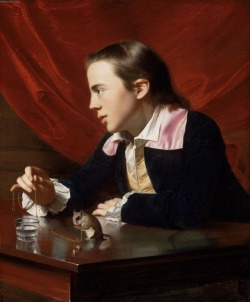At this time the artist is the foremost portrait painter in Boston and arguably in all of colonial America. He longs, however, to be a history painter and to be accepted by his idols in England such as Sir Joshua Reynolds. The painting is sent to London and is highly praised and Copley is encouraged to come to London for training. The author discusses the painting and how the transit from North America to England contributes to its meaning. She states that the medium of the work is not only oil on canvas, but “oil on canvas on a merchant ship on the Atlantic Ocean.” (Interesting thought!!) The subject of the painting is Copley’s half-brother Henry Pelham. The young man is shown at a table, holding a squirrel on a chain, next to a glass of water on the table. The author states that the glass of water is present to show Copley’s skill at representing transparency and reflections. The author also states that the presence of the water represents the Atlantic Ocean. The chain held by the boy spans the circumference of the water glass as if to represent the painting’s journey across the ocean. The presence of the squirrel (actually a flying squirrel) on a chain is also common in American portraiture of children to represent diligence, patience, and Lockean education that includes the domestication of a wild animal. In addition to this the author points out that the terms “squirrel” and “flying squirrel” were also used as common names for schooners and sloops that passed through the harbor of Boston. The flying squirrel is also the perfect animal representation of a stretched canvas. This type of squirrel can also represent movement and transit of the painting. The squirrel is also the epitome of a three-dimensional object becoming a two dimensional object which is often related to the art of painting. When sitting still the squirrel is a very three-dimensional animal, but when needing to fly to a new destination the animal flattens itself out considerably. There is also much made of the representation of the boy in profile which is quite unusual in Copley’s portraits and in mid eighteenth-century painting in general. While the curtain in the background and the boy himself are somewhat flat, the table is not and cuts onto the space emphasizing three-dimensional space. Another aspect of the painting discussed by the author is the idea of sensory perception. The curtain is said to be a transition point from the flatness of the profile to the three-dimensionality of the table. The red curtain in the background has many strange shapes found in the folds. One shape mimics the shape of the boy’s eye and the curve of his palm and sleeve. Another shape in the curtain mimics the boy’s ear. The author states that these and other devices allow the boy to be depicted looking one way and yet listening behind him. The ear and references to hearing might also be a reference to Copley’s desire to hear the reactions to his painting once it arrives in London without its creator. All of these references to sensory perception may also indicate the ideas of John Locke and his empiricism. Empiricism states that knowledge is based on sense experience rather than innate ideas. The author concludes that the painting is a new aesthetic about transit and transformation.
I just adore how art can be read on so many different levels. It is articles like this that make me want to always continue learning more.


 RSS Feed
RSS Feed
